SAP S/4HANA Finance: Revolutionizing the Business Industry
VerifiedAdded on 2022/10/01
|13
|3863
|423
AI Summary
This report discusses the benefits of SAP S/4HANA Finance in revolutionizing the business industry by simplifying processes, consolidating data, and providing real-time insights. It includes an overview of SAP S/4HANA Finance, a comparison with SAP ERP FICO, and the business benefits of SAP S/4HANA Finance. The report also includes case studies of Fujitsu and ENGIE, highlighting the challenges they faced and how SAP S/4HANA Finance helped them overcome those challenges. The report concludes with the criteria for successful implementation.
Contribute Materials
Your contribution can guide someone’s learning journey. Share your
documents today.
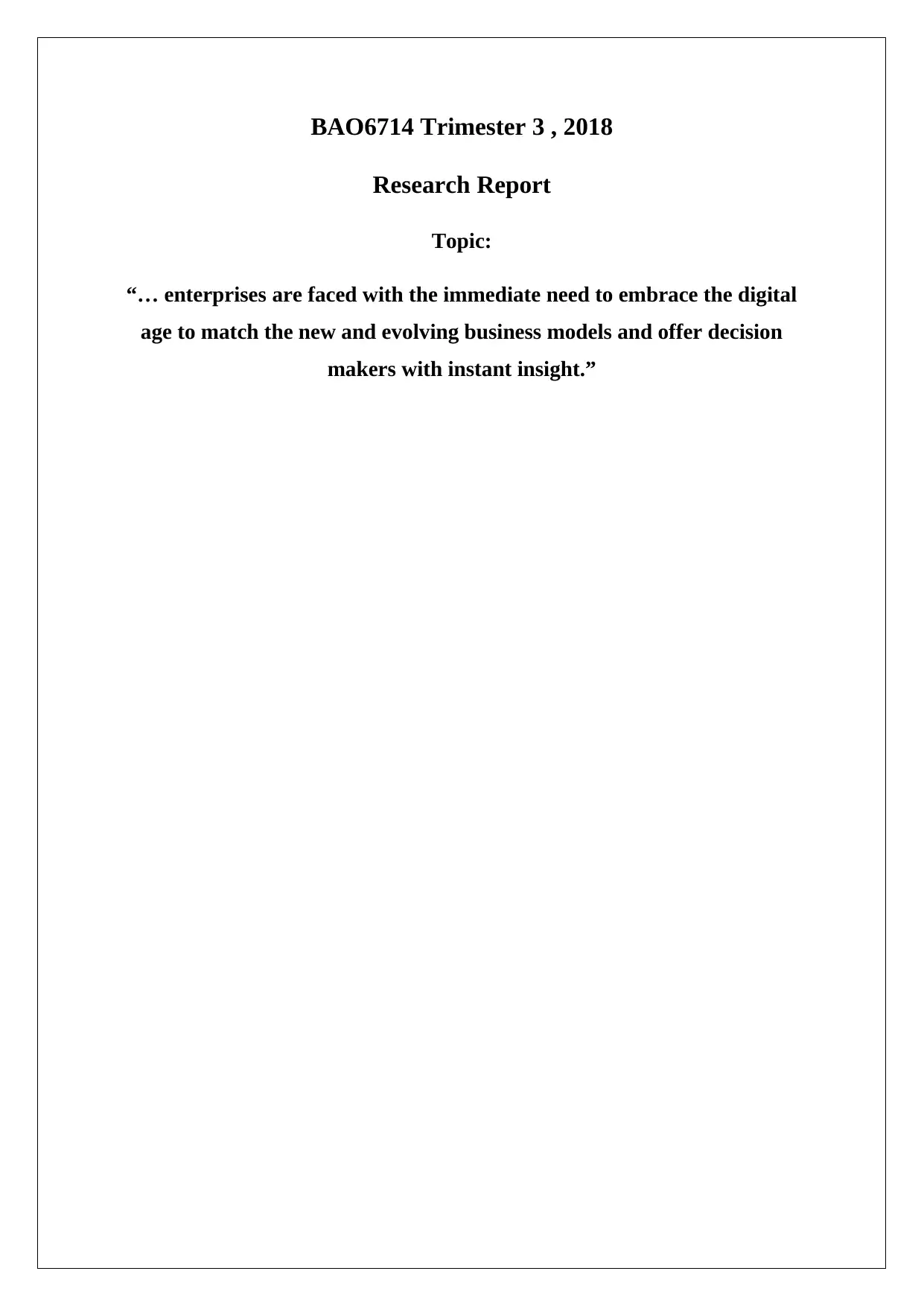
BAO6714 Trimester 3 , 2018
Research Report
Topic:
“… enterprises are faced with the immediate need to embrace the digital
age to match the new and evolving business models and offer decision
makers with instant insight.”
Research Report
Topic:
“… enterprises are faced with the immediate need to embrace the digital
age to match the new and evolving business models and offer decision
makers with instant insight.”
Secure Best Marks with AI Grader
Need help grading? Try our AI Grader for instant feedback on your assignments.
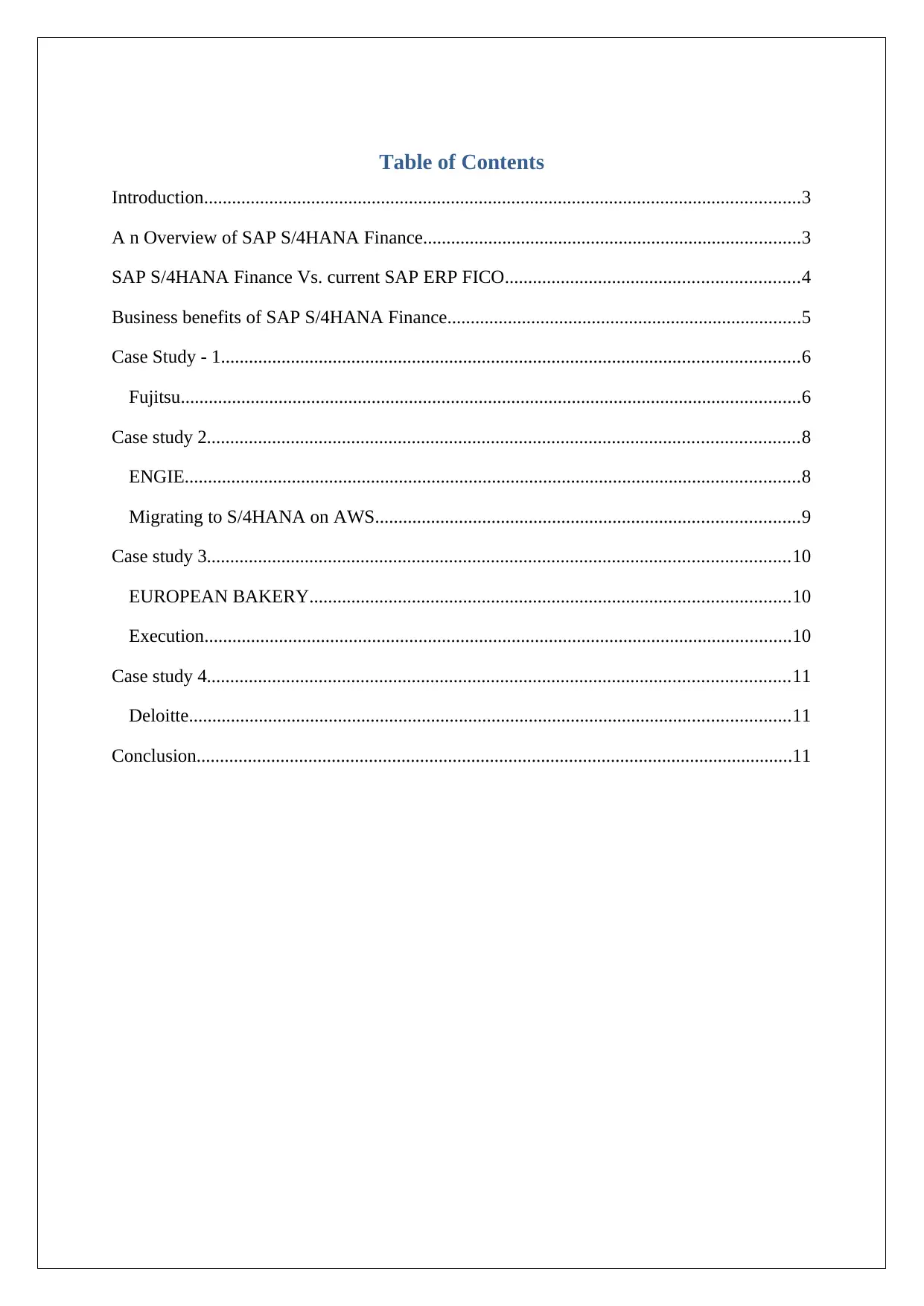
Table of Contents
Introduction................................................................................................................................3
A n Overview of SAP S/4HANA Finance.................................................................................3
SAP S/4HANA Finance Vs. current SAP ERP FICO...............................................................4
Business benefits of SAP S/4HANA Finance............................................................................5
Case Study - 1............................................................................................................................6
Fujitsu.....................................................................................................................................6
Case study 2...............................................................................................................................8
ENGIE....................................................................................................................................8
Migrating to S/4HANA on AWS...........................................................................................9
Case study 3.............................................................................................................................10
EUROPEAN BAKERY.......................................................................................................10
Execution..............................................................................................................................10
Case study 4.............................................................................................................................11
Deloitte.................................................................................................................................11
Conclusion................................................................................................................................11
Introduction................................................................................................................................3
A n Overview of SAP S/4HANA Finance.................................................................................3
SAP S/4HANA Finance Vs. current SAP ERP FICO...............................................................4
Business benefits of SAP S/4HANA Finance............................................................................5
Case Study - 1............................................................................................................................6
Fujitsu.....................................................................................................................................6
Case study 2...............................................................................................................................8
ENGIE....................................................................................................................................8
Migrating to S/4HANA on AWS...........................................................................................9
Case study 3.............................................................................................................................10
EUROPEAN BAKERY.......................................................................................................10
Execution..............................................................................................................................10
Case study 4.............................................................................................................................11
Deloitte.................................................................................................................................11
Conclusion................................................................................................................................11
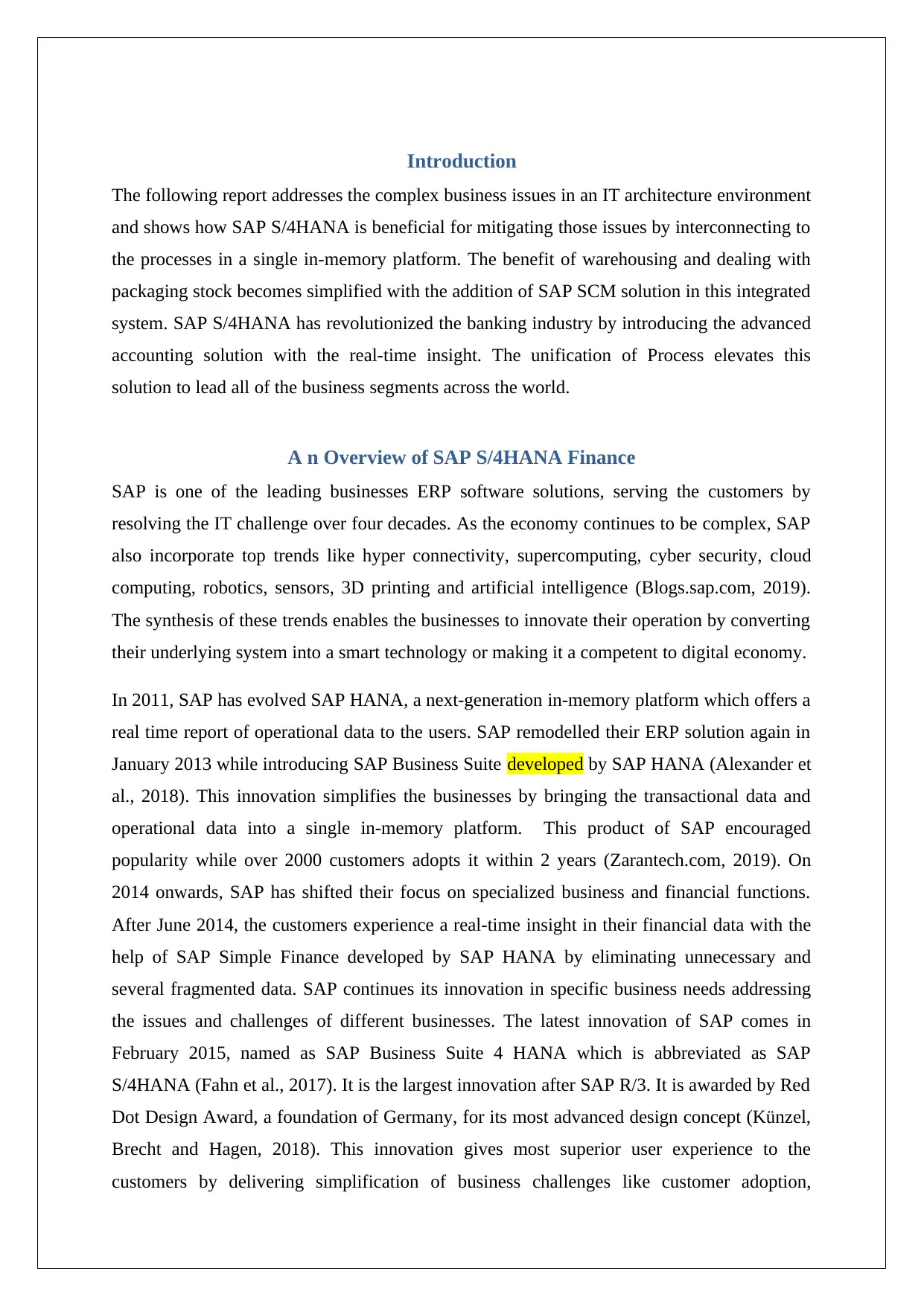
Introduction
The following report addresses the complex business issues in an IT architecture environment
and shows how SAP S/4HANA is beneficial for mitigating those issues by interconnecting to
the processes in a single in-memory platform. The benefit of warehousing and dealing with
packaging stock becomes simplified with the addition of SAP SCM solution in this integrated
system. SAP S/4HANA has revolutionized the banking industry by introducing the advanced
accounting solution with the real-time insight. The unification of Process elevates this
solution to lead all of the business segments across the world.
A n Overview of SAP S/4HANA Finance
SAP is one of the leading businesses ERP software solutions, serving the customers by
resolving the IT challenge over four decades. As the economy continues to be complex, SAP
also incorporate top trends like hyper connectivity, supercomputing, cyber security, cloud
computing, robotics, sensors, 3D printing and artificial intelligence (Blogs.sap.com, 2019).
The synthesis of these trends enables the businesses to innovate their operation by converting
their underlying system into a smart technology or making it a competent to digital economy.
In 2011, SAP has evolved SAP HANA, a next-generation in-memory platform which offers a
real time report of operational data to the users. SAP remodelled their ERP solution again in
January 2013 while introducing SAP Business Suite developed by SAP HANA (Alexander et
al., 2018). This innovation simplifies the businesses by bringing the transactional data and
operational data into a single in-memory platform. This product of SAP encouraged
popularity while over 2000 customers adopts it within 2 years (Zarantech.com, 2019). On
2014 onwards, SAP has shifted their focus on specialized business and financial functions.
After June 2014, the customers experience a real-time insight in their financial data with the
help of SAP Simple Finance developed by SAP HANA by eliminating unnecessary and
several fragmented data. SAP continues its innovation in specific business needs addressing
the issues and challenges of different businesses. The latest innovation of SAP comes in
February 2015, named as SAP Business Suite 4 HANA which is abbreviated as SAP
S/4HANA (Fahn et al., 2017). It is the largest innovation after SAP R/3. It is awarded by Red
Dot Design Award, a foundation of Germany, for its most advanced design concept (Künzel,
Brecht and Hagen, 2018). This innovation gives most superior user experience to the
customers by delivering simplification of business challenges like customer adoption,
The following report addresses the complex business issues in an IT architecture environment
and shows how SAP S/4HANA is beneficial for mitigating those issues by interconnecting to
the processes in a single in-memory platform. The benefit of warehousing and dealing with
packaging stock becomes simplified with the addition of SAP SCM solution in this integrated
system. SAP S/4HANA has revolutionized the banking industry by introducing the advanced
accounting solution with the real-time insight. The unification of Process elevates this
solution to lead all of the business segments across the world.
A n Overview of SAP S/4HANA Finance
SAP is one of the leading businesses ERP software solutions, serving the customers by
resolving the IT challenge over four decades. As the economy continues to be complex, SAP
also incorporate top trends like hyper connectivity, supercomputing, cyber security, cloud
computing, robotics, sensors, 3D printing and artificial intelligence (Blogs.sap.com, 2019).
The synthesis of these trends enables the businesses to innovate their operation by converting
their underlying system into a smart technology or making it a competent to digital economy.
In 2011, SAP has evolved SAP HANA, a next-generation in-memory platform which offers a
real time report of operational data to the users. SAP remodelled their ERP solution again in
January 2013 while introducing SAP Business Suite developed by SAP HANA (Alexander et
al., 2018). This innovation simplifies the businesses by bringing the transactional data and
operational data into a single in-memory platform. This product of SAP encouraged
popularity while over 2000 customers adopts it within 2 years (Zarantech.com, 2019). On
2014 onwards, SAP has shifted their focus on specialized business and financial functions.
After June 2014, the customers experience a real-time insight in their financial data with the
help of SAP Simple Finance developed by SAP HANA by eliminating unnecessary and
several fragmented data. SAP continues its innovation in specific business needs addressing
the issues and challenges of different businesses. The latest innovation of SAP comes in
February 2015, named as SAP Business Suite 4 HANA which is abbreviated as SAP
S/4HANA (Fahn et al., 2017). It is the largest innovation after SAP R/3. It is awarded by Red
Dot Design Award, a foundation of Germany, for its most advanced design concept (Künzel,
Brecht and Hagen, 2018). This innovation gives most superior user experience to the
customers by delivering simplification of business challenges like customer adoption,
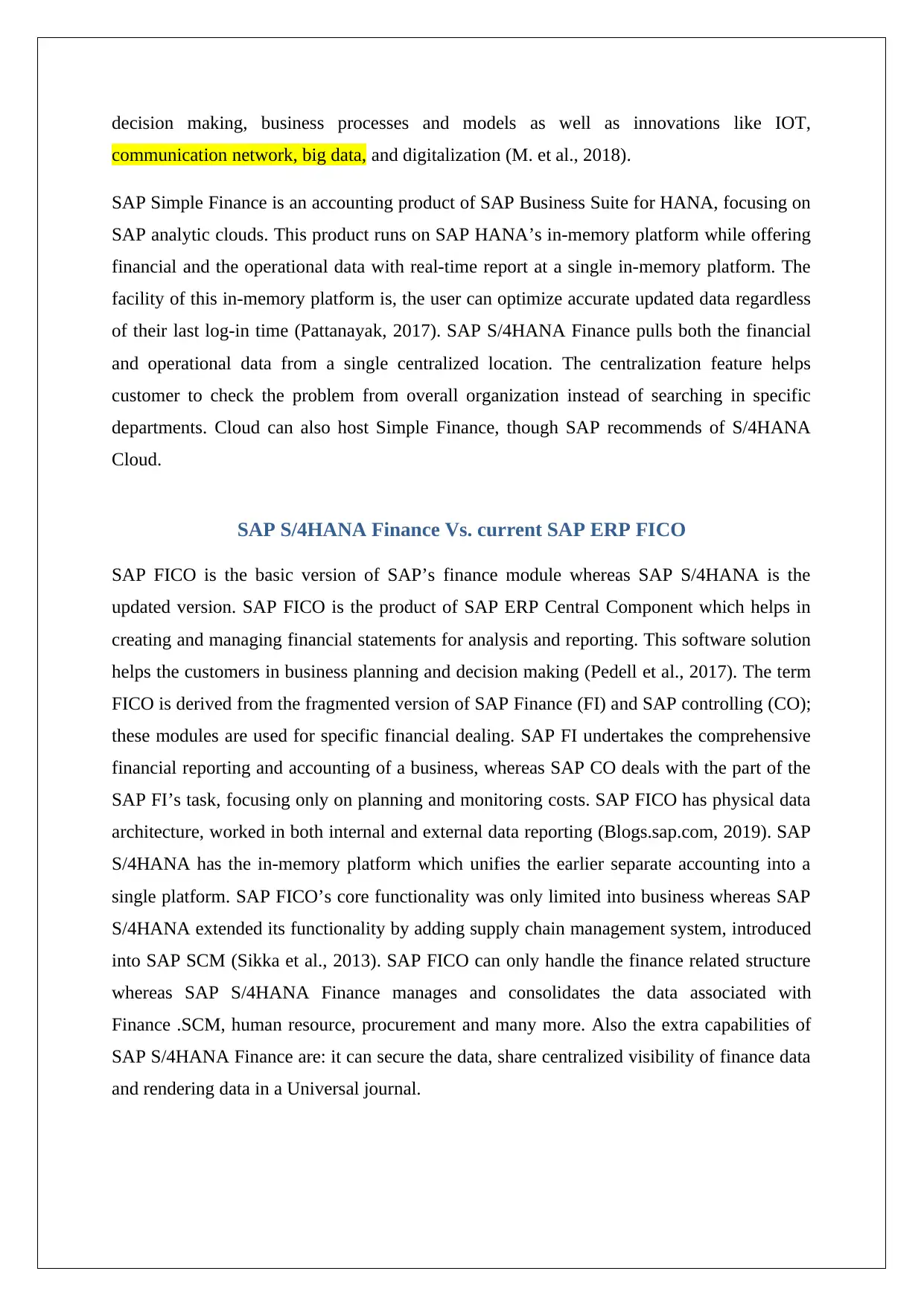
decision making, business processes and models as well as innovations like IOT,
communication network, big data, and digitalization (M. et al., 2018).
SAP Simple Finance is an accounting product of SAP Business Suite for HANA, focusing on
SAP analytic clouds. This product runs on SAP HANA’s in-memory platform while offering
financial and the operational data with real-time report at a single in-memory platform. The
facility of this in-memory platform is, the user can optimize accurate updated data regardless
of their last log-in time (Pattanayak, 2017). SAP S/4HANA Finance pulls both the financial
and operational data from a single centralized location. The centralization feature helps
customer to check the problem from overall organization instead of searching in specific
departments. Cloud can also host Simple Finance, though SAP recommends of S/4HANA
Cloud.
SAP S/4HANA Finance Vs. current SAP ERP FICO
SAP FICO is the basic version of SAP’s finance module whereas SAP S/4HANA is the
updated version. SAP FICO is the product of SAP ERP Central Component which helps in
creating and managing financial statements for analysis and reporting. This software solution
helps the customers in business planning and decision making (Pedell et al., 2017). The term
FICO is derived from the fragmented version of SAP Finance (FI) and SAP controlling (CO);
these modules are used for specific financial dealing. SAP FI undertakes the comprehensive
financial reporting and accounting of a business, whereas SAP CO deals with the part of the
SAP FI’s task, focusing only on planning and monitoring costs. SAP FICO has physical data
architecture, worked in both internal and external data reporting (Blogs.sap.com, 2019). SAP
S/4HANA has the in-memory platform which unifies the earlier separate accounting into a
single platform. SAP FICO’s core functionality was only limited into business whereas SAP
S/4HANA extended its functionality by adding supply chain management system, introduced
into SAP SCM (Sikka et al., 2013). SAP FICO can only handle the finance related structure
whereas SAP S/4HANA Finance manages and consolidates the data associated with
Finance .SCM, human resource, procurement and many more. Also the extra capabilities of
SAP S/4HANA Finance are: it can secure the data, share centralized visibility of finance data
and rendering data in a Universal journal.
communication network, big data, and digitalization (M. et al., 2018).
SAP Simple Finance is an accounting product of SAP Business Suite for HANA, focusing on
SAP analytic clouds. This product runs on SAP HANA’s in-memory platform while offering
financial and the operational data with real-time report at a single in-memory platform. The
facility of this in-memory platform is, the user can optimize accurate updated data regardless
of their last log-in time (Pattanayak, 2017). SAP S/4HANA Finance pulls both the financial
and operational data from a single centralized location. The centralization feature helps
customer to check the problem from overall organization instead of searching in specific
departments. Cloud can also host Simple Finance, though SAP recommends of S/4HANA
Cloud.
SAP S/4HANA Finance Vs. current SAP ERP FICO
SAP FICO is the basic version of SAP’s finance module whereas SAP S/4HANA is the
updated version. SAP FICO is the product of SAP ERP Central Component which helps in
creating and managing financial statements for analysis and reporting. This software solution
helps the customers in business planning and decision making (Pedell et al., 2017). The term
FICO is derived from the fragmented version of SAP Finance (FI) and SAP controlling (CO);
these modules are used for specific financial dealing. SAP FI undertakes the comprehensive
financial reporting and accounting of a business, whereas SAP CO deals with the part of the
SAP FI’s task, focusing only on planning and monitoring costs. SAP FICO has physical data
architecture, worked in both internal and external data reporting (Blogs.sap.com, 2019). SAP
S/4HANA has the in-memory platform which unifies the earlier separate accounting into a
single platform. SAP FICO’s core functionality was only limited into business whereas SAP
S/4HANA extended its functionality by adding supply chain management system, introduced
into SAP SCM (Sikka et al., 2013). SAP FICO can only handle the finance related structure
whereas SAP S/4HANA Finance manages and consolidates the data associated with
Finance .SCM, human resource, procurement and many more. Also the extra capabilities of
SAP S/4HANA Finance are: it can secure the data, share centralized visibility of finance data
and rendering data in a Universal journal.
Secure Best Marks with AI Grader
Need help grading? Try our AI Grader for instant feedback on your assignments.
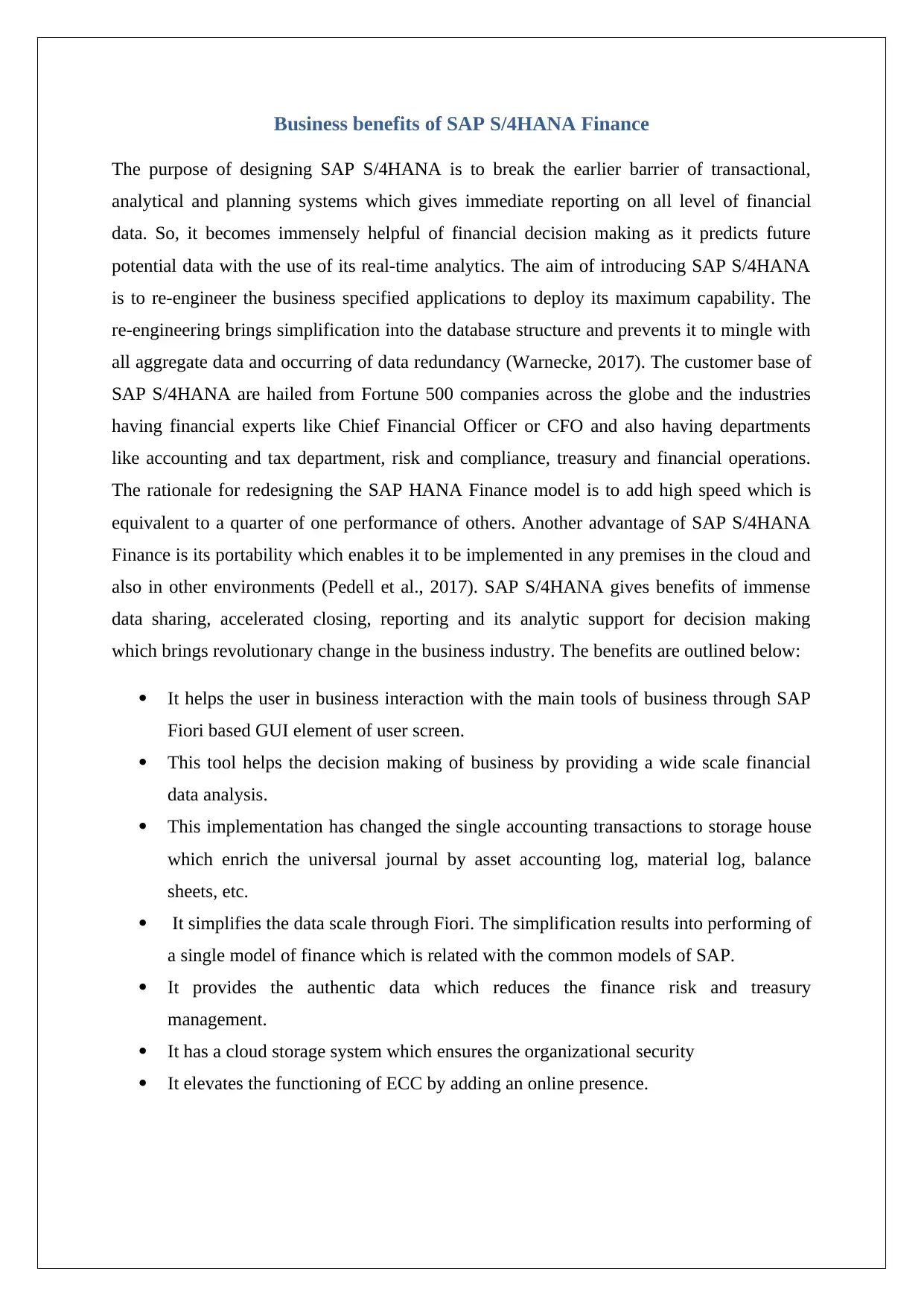
Business benefits of SAP S/4HANA Finance
The purpose of designing SAP S/4HANA is to break the earlier barrier of transactional,
analytical and planning systems which gives immediate reporting on all level of financial
data. So, it becomes immensely helpful of financial decision making as it predicts future
potential data with the use of its real-time analytics. The aim of introducing SAP S/4HANA
is to re-engineer the business specified applications to deploy its maximum capability. The
re-engineering brings simplification into the database structure and prevents it to mingle with
all aggregate data and occurring of data redundancy (Warnecke, 2017). The customer base of
SAP S/4HANA are hailed from Fortune 500 companies across the globe and the industries
having financial experts like Chief Financial Officer or CFO and also having departments
like accounting and tax department, risk and compliance, treasury and financial operations.
The rationale for redesigning the SAP HANA Finance model is to add high speed which is
equivalent to a quarter of one performance of others. Another advantage of SAP S/4HANA
Finance is its portability which enables it to be implemented in any premises in the cloud and
also in other environments (Pedell et al., 2017). SAP S/4HANA gives benefits of immense
data sharing, accelerated closing, reporting and its analytic support for decision making
which brings revolutionary change in the business industry. The benefits are outlined below:
It helps the user in business interaction with the main tools of business through SAP
Fiori based GUI element of user screen.
This tool helps the decision making of business by providing a wide scale financial
data analysis.
This implementation has changed the single accounting transactions to storage house
which enrich the universal journal by asset accounting log, material log, balance
sheets, etc.
It simplifies the data scale through Fiori. The simplification results into performing of
a single model of finance which is related with the common models of SAP.
It provides the authentic data which reduces the finance risk and treasury
management.
It has a cloud storage system which ensures the organizational security
It elevates the functioning of ECC by adding an online presence.
The purpose of designing SAP S/4HANA is to break the earlier barrier of transactional,
analytical and planning systems which gives immediate reporting on all level of financial
data. So, it becomes immensely helpful of financial decision making as it predicts future
potential data with the use of its real-time analytics. The aim of introducing SAP S/4HANA
is to re-engineer the business specified applications to deploy its maximum capability. The
re-engineering brings simplification into the database structure and prevents it to mingle with
all aggregate data and occurring of data redundancy (Warnecke, 2017). The customer base of
SAP S/4HANA are hailed from Fortune 500 companies across the globe and the industries
having financial experts like Chief Financial Officer or CFO and also having departments
like accounting and tax department, risk and compliance, treasury and financial operations.
The rationale for redesigning the SAP HANA Finance model is to add high speed which is
equivalent to a quarter of one performance of others. Another advantage of SAP S/4HANA
Finance is its portability which enables it to be implemented in any premises in the cloud and
also in other environments (Pedell et al., 2017). SAP S/4HANA gives benefits of immense
data sharing, accelerated closing, reporting and its analytic support for decision making
which brings revolutionary change in the business industry. The benefits are outlined below:
It helps the user in business interaction with the main tools of business through SAP
Fiori based GUI element of user screen.
This tool helps the decision making of business by providing a wide scale financial
data analysis.
This implementation has changed the single accounting transactions to storage house
which enrich the universal journal by asset accounting log, material log, balance
sheets, etc.
It simplifies the data scale through Fiori. The simplification results into performing of
a single model of finance which is related with the common models of SAP.
It provides the authentic data which reduces the finance risk and treasury
management.
It has a cloud storage system which ensures the organizational security
It elevates the functioning of ECC by adding an online presence.
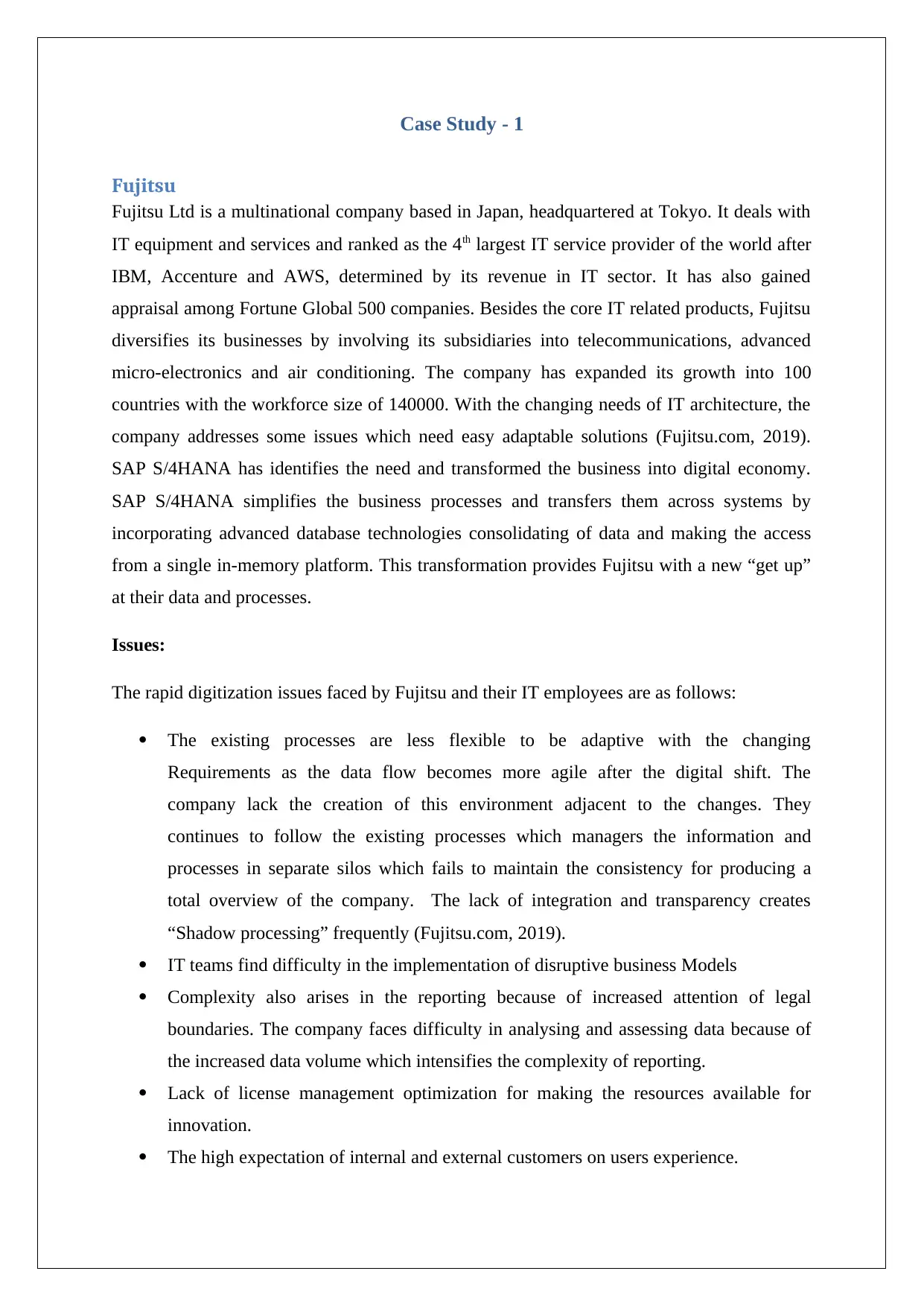
Case Study - 1
Fujitsu
Fujitsu Ltd is a multinational company based in Japan, headquartered at Tokyo. It deals with
IT equipment and services and ranked as the 4th largest IT service provider of the world after
IBM, Accenture and AWS, determined by its revenue in IT sector. It has also gained
appraisal among Fortune Global 500 companies. Besides the core IT related products, Fujitsu
diversifies its businesses by involving its subsidiaries into telecommunications, advanced
micro-electronics and air conditioning. The company has expanded its growth into 100
countries with the workforce size of 140000. With the changing needs of IT architecture, the
company addresses some issues which need easy adaptable solutions (Fujitsu.com, 2019).
SAP S/4HANA has identifies the need and transformed the business into digital economy.
SAP S/4HANA simplifies the business processes and transfers them across systems by
incorporating advanced database technologies consolidating of data and making the access
from a single in-memory platform. This transformation provides Fujitsu with a new “get up”
at their data and processes.
Issues:
The rapid digitization issues faced by Fujitsu and their IT employees are as follows:
The existing processes are less flexible to be adaptive with the changing
Requirements as the data flow becomes more agile after the digital shift. The
company lack the creation of this environment adjacent to the changes. They
continues to follow the existing processes which managers the information and
processes in separate silos which fails to maintain the consistency for producing a
total overview of the company. The lack of integration and transparency creates
“Shadow processing” frequently (Fujitsu.com, 2019).
IT teams find difficulty in the implementation of disruptive business Models
Complexity also arises in the reporting because of increased attention of legal
boundaries. The company faces difficulty in analysing and assessing data because of
the increased data volume which intensifies the complexity of reporting.
Lack of license management optimization for making the resources available for
innovation.
The high expectation of internal and external customers on users experience.
Fujitsu
Fujitsu Ltd is a multinational company based in Japan, headquartered at Tokyo. It deals with
IT equipment and services and ranked as the 4th largest IT service provider of the world after
IBM, Accenture and AWS, determined by its revenue in IT sector. It has also gained
appraisal among Fortune Global 500 companies. Besides the core IT related products, Fujitsu
diversifies its businesses by involving its subsidiaries into telecommunications, advanced
micro-electronics and air conditioning. The company has expanded its growth into 100
countries with the workforce size of 140000. With the changing needs of IT architecture, the
company addresses some issues which need easy adaptable solutions (Fujitsu.com, 2019).
SAP S/4HANA has identifies the need and transformed the business into digital economy.
SAP S/4HANA simplifies the business processes and transfers them across systems by
incorporating advanced database technologies consolidating of data and making the access
from a single in-memory platform. This transformation provides Fujitsu with a new “get up”
at their data and processes.
Issues:
The rapid digitization issues faced by Fujitsu and their IT employees are as follows:
The existing processes are less flexible to be adaptive with the changing
Requirements as the data flow becomes more agile after the digital shift. The
company lack the creation of this environment adjacent to the changes. They
continues to follow the existing processes which managers the information and
processes in separate silos which fails to maintain the consistency for producing a
total overview of the company. The lack of integration and transparency creates
“Shadow processing” frequently (Fujitsu.com, 2019).
IT teams find difficulty in the implementation of disruptive business Models
Complexity also arises in the reporting because of increased attention of legal
boundaries. The company faces difficulty in analysing and assessing data because of
the increased data volume which intensifies the complexity of reporting.
Lack of license management optimization for making the resources available for
innovation.
The high expectation of internal and external customers on users experience.
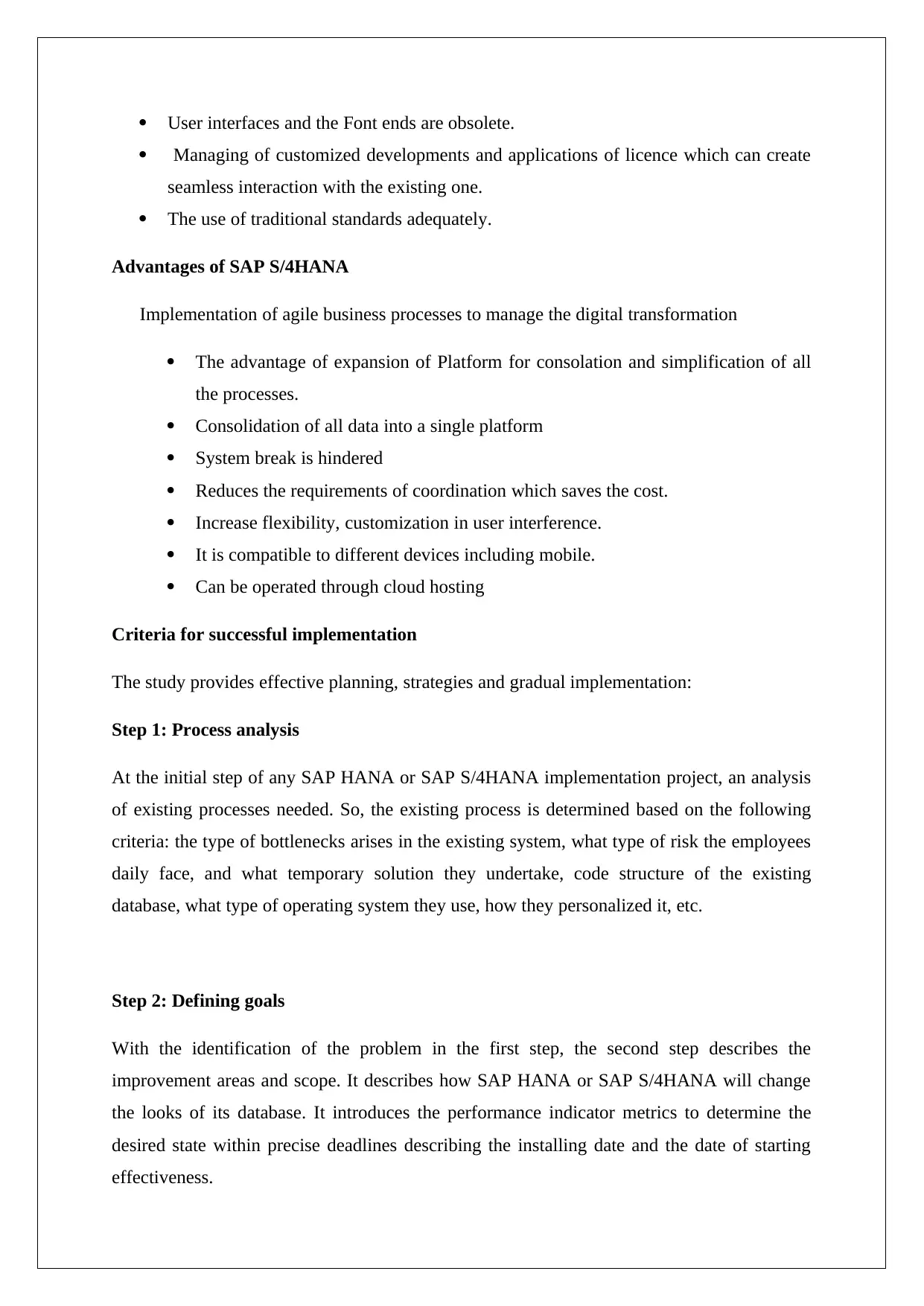
User interfaces and the Font ends are obsolete.
Managing of customized developments and applications of licence which can create
seamless interaction with the existing one.
The use of traditional standards adequately.
Advantages of SAP S/4HANA
Implementation of agile business processes to manage the digital transformation
The advantage of expansion of Platform for consolation and simplification of all
the processes.
Consolidation of all data into a single platform
System break is hindered
Reduces the requirements of coordination which saves the cost.
Increase flexibility, customization in user interference.
It is compatible to different devices including mobile.
Can be operated through cloud hosting
Criteria for successful implementation
The study provides effective planning, strategies and gradual implementation:
Step 1: Process analysis
At the initial step of any SAP HANA or SAP S/4HANA implementation project, an analysis
of existing processes needed. So, the existing process is determined based on the following
criteria: the type of bottlenecks arises in the existing system, what type of risk the employees
daily face, and what temporary solution they undertake, code structure of the existing
database, what type of operating system they use, how they personalized it, etc.
Step 2: Defining goals
With the identification of the problem in the first step, the second step describes the
improvement areas and scope. It describes how SAP HANA or SAP S/4HANA will change
the looks of its database. It introduces the performance indicator metrics to determine the
desired state within precise deadlines describing the installing date and the date of starting
effectiveness.
Managing of customized developments and applications of licence which can create
seamless interaction with the existing one.
The use of traditional standards adequately.
Advantages of SAP S/4HANA
Implementation of agile business processes to manage the digital transformation
The advantage of expansion of Platform for consolation and simplification of all
the processes.
Consolidation of all data into a single platform
System break is hindered
Reduces the requirements of coordination which saves the cost.
Increase flexibility, customization in user interference.
It is compatible to different devices including mobile.
Can be operated through cloud hosting
Criteria for successful implementation
The study provides effective planning, strategies and gradual implementation:
Step 1: Process analysis
At the initial step of any SAP HANA or SAP S/4HANA implementation project, an analysis
of existing processes needed. So, the existing process is determined based on the following
criteria: the type of bottlenecks arises in the existing system, what type of risk the employees
daily face, and what temporary solution they undertake, code structure of the existing
database, what type of operating system they use, how they personalized it, etc.
Step 2: Defining goals
With the identification of the problem in the first step, the second step describes the
improvement areas and scope. It describes how SAP HANA or SAP S/4HANA will change
the looks of its database. It introduces the performance indicator metrics to determine the
desired state within precise deadlines describing the installing date and the date of starting
effectiveness.
Paraphrase This Document
Need a fresh take? Get an instant paraphrase of this document with our AI Paraphraser
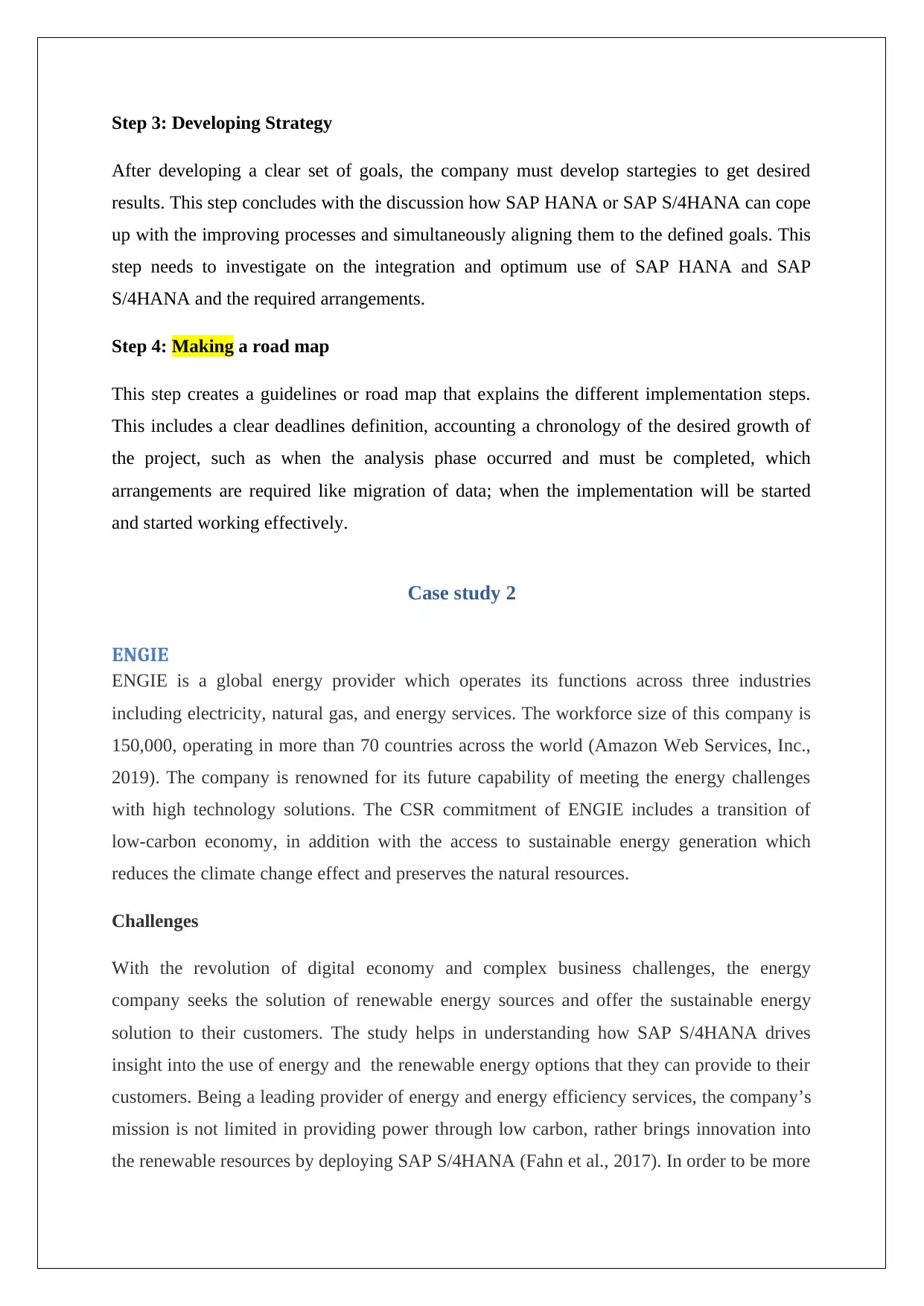
Step 3: Developing Strategy
After developing a clear set of goals, the company must develop startegies to get desired
results. This step concludes with the discussion how SAP HANA or SAP S/4HANA can cope
up with the improving processes and simultaneously aligning them to the defined goals. This
step needs to investigate on the integration and optimum use of SAP HANA and SAP
S/4HANA and the required arrangements.
Step 4: Making a road map
This step creates a guidelines or road map that explains the different implementation steps.
This includes a clear deadlines definition, accounting a chronology of the desired growth of
the project, such as when the analysis phase occurred and must be completed, which
arrangements are required like migration of data; when the implementation will be started
and started working effectively.
Case study 2
ENGIE
ENGIE is a global energy provider which operates its functions across three industries
including electricity, natural gas, and energy services. The workforce size of this company is
150,000, operating in more than 70 countries across the world (Amazon Web Services, Inc.,
2019). The company is renowned for its future capability of meeting the energy challenges
with high technology solutions. The CSR commitment of ENGIE includes a transition of
low-carbon economy, in addition with the access to sustainable energy generation which
reduces the climate change effect and preserves the natural resources.
Challenges
With the revolution of digital economy and complex business challenges, the energy
company seeks the solution of renewable energy sources and offer the sustainable energy
solution to their customers. The study helps in understanding how SAP S/4HANA drives
insight into the use of energy and the renewable energy options that they can provide to their
customers. Being a leading provider of energy and energy efficiency services, the company’s
mission is not limited in providing power through low carbon, rather brings innovation into
the renewable resources by deploying SAP S/4HANA (Fahn et al., 2017). In order to be more
After developing a clear set of goals, the company must develop startegies to get desired
results. This step concludes with the discussion how SAP HANA or SAP S/4HANA can cope
up with the improving processes and simultaneously aligning them to the defined goals. This
step needs to investigate on the integration and optimum use of SAP HANA and SAP
S/4HANA and the required arrangements.
Step 4: Making a road map
This step creates a guidelines or road map that explains the different implementation steps.
This includes a clear deadlines definition, accounting a chronology of the desired growth of
the project, such as when the analysis phase occurred and must be completed, which
arrangements are required like migration of data; when the implementation will be started
and started working effectively.
Case study 2
ENGIE
ENGIE is a global energy provider which operates its functions across three industries
including electricity, natural gas, and energy services. The workforce size of this company is
150,000, operating in more than 70 countries across the world (Amazon Web Services, Inc.,
2019). The company is renowned for its future capability of meeting the energy challenges
with high technology solutions. The CSR commitment of ENGIE includes a transition of
low-carbon economy, in addition with the access to sustainable energy generation which
reduces the climate change effect and preserves the natural resources.
Challenges
With the revolution of digital economy and complex business challenges, the energy
company seeks the solution of renewable energy sources and offer the sustainable energy
solution to their customers. The study helps in understanding how SAP S/4HANA drives
insight into the use of energy and the renewable energy options that they can provide to their
customers. Being a leading provider of energy and energy efficiency services, the company’s
mission is not limited in providing power through low carbon, rather brings innovation into
the renewable resources by deploying SAP S/4HANA (Fahn et al., 2017). In order to be more
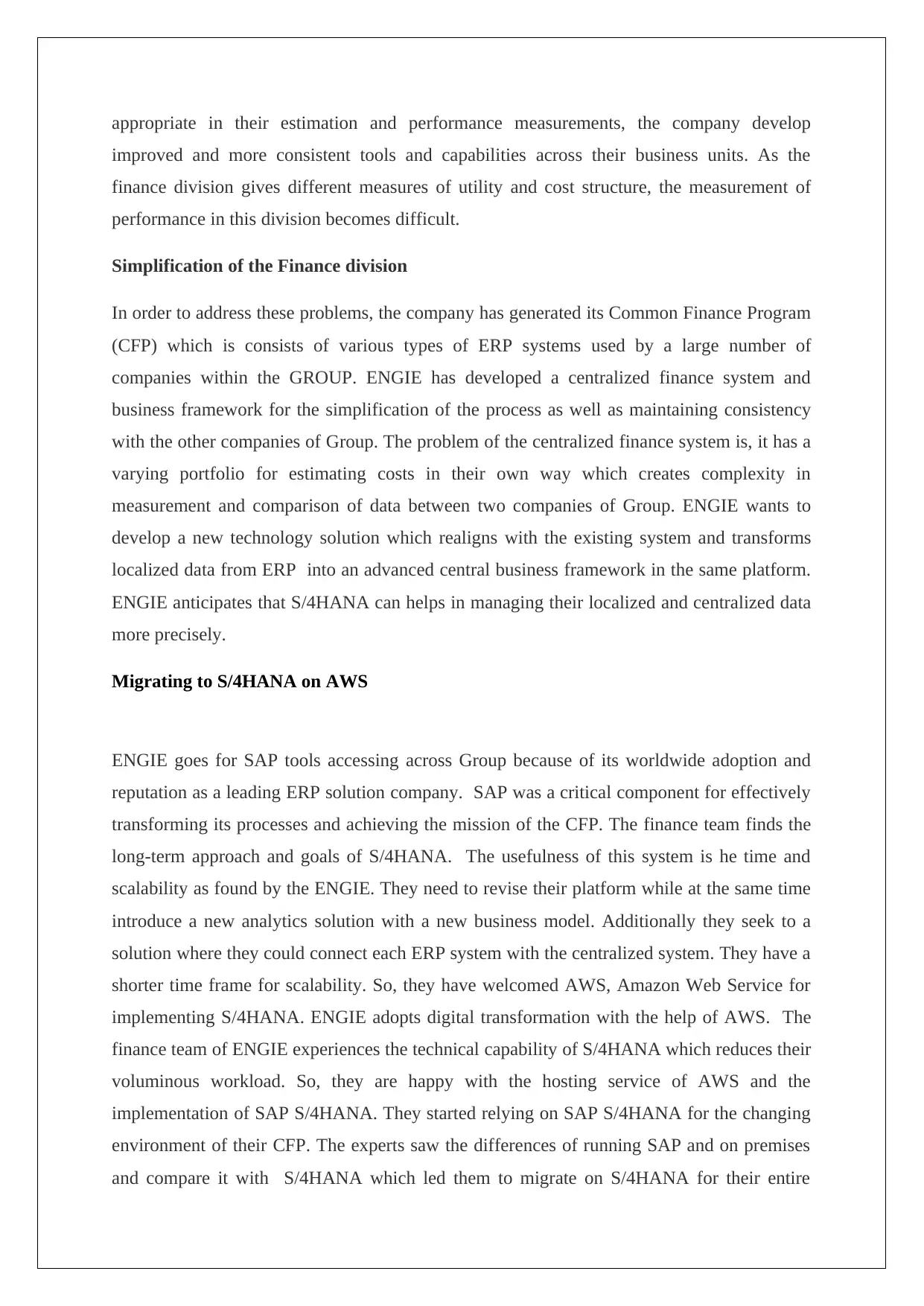
appropriate in their estimation and performance measurements, the company develop
improved and more consistent tools and capabilities across their business units. As the
finance division gives different measures of utility and cost structure, the measurement of
performance in this division becomes difficult.
Simplification of the Finance division
In order to address these problems, the company has generated its Common Finance Program
(CFP) which is consists of various types of ERP systems used by a large number of
companies within the GROUP. ENGIE has developed a centralized finance system and
business framework for the simplification of the process as well as maintaining consistency
with the other companies of Group. The problem of the centralized finance system is, it has a
varying portfolio for estimating costs in their own way which creates complexity in
measurement and comparison of data between two companies of Group. ENGIE wants to
develop a new technology solution which realigns with the existing system and transforms
localized data from ERP into an advanced central business framework in the same platform.
ENGIE anticipates that S/4HANA can helps in managing their localized and centralized data
more precisely.
Migrating to S/4HANA on AWS
ENGIE goes for SAP tools accessing across Group because of its worldwide adoption and
reputation as a leading ERP solution company. SAP was a critical component for effectively
transforming its processes and achieving the mission of the CFP. The finance team finds the
long-term approach and goals of S/4HANA. The usefulness of this system is he time and
scalability as found by the ENGIE. They need to revise their platform while at the same time
introduce a new analytics solution with a new business model. Additionally they seek to a
solution where they could connect each ERP system with the centralized system. They have a
shorter time frame for scalability. So, they have welcomed AWS, Amazon Web Service for
implementing S/4HANA. ENGIE adopts digital transformation with the help of AWS. The
finance team of ENGIE experiences the technical capability of S/4HANA which reduces their
voluminous workload. So, they are happy with the hosting service of AWS and the
implementation of SAP S/4HANA. They started relying on SAP S/4HANA for the changing
environment of their CFP. The experts saw the differences of running SAP and on premises
and compare it with S/4HANA which led them to migrate on S/4HANA for their entire
improved and more consistent tools and capabilities across their business units. As the
finance division gives different measures of utility and cost structure, the measurement of
performance in this division becomes difficult.
Simplification of the Finance division
In order to address these problems, the company has generated its Common Finance Program
(CFP) which is consists of various types of ERP systems used by a large number of
companies within the GROUP. ENGIE has developed a centralized finance system and
business framework for the simplification of the process as well as maintaining consistency
with the other companies of Group. The problem of the centralized finance system is, it has a
varying portfolio for estimating costs in their own way which creates complexity in
measurement and comparison of data between two companies of Group. ENGIE wants to
develop a new technology solution which realigns with the existing system and transforms
localized data from ERP into an advanced central business framework in the same platform.
ENGIE anticipates that S/4HANA can helps in managing their localized and centralized data
more precisely.
Migrating to S/4HANA on AWS
ENGIE goes for SAP tools accessing across Group because of its worldwide adoption and
reputation as a leading ERP solution company. SAP was a critical component for effectively
transforming its processes and achieving the mission of the CFP. The finance team finds the
long-term approach and goals of S/4HANA. The usefulness of this system is he time and
scalability as found by the ENGIE. They need to revise their platform while at the same time
introduce a new analytics solution with a new business model. Additionally they seek to a
solution where they could connect each ERP system with the centralized system. They have a
shorter time frame for scalability. So, they have welcomed AWS, Amazon Web Service for
implementing S/4HANA. ENGIE adopts digital transformation with the help of AWS. The
finance team of ENGIE experiences the technical capability of S/4HANA which reduces their
voluminous workload. So, they are happy with the hosting service of AWS and the
implementation of SAP S/4HANA. They started relying on SAP S/4HANA for the changing
environment of their CFP. The experts saw the differences of running SAP and on premises
and compare it with S/4HANA which led them to migrate on S/4HANA for their entire
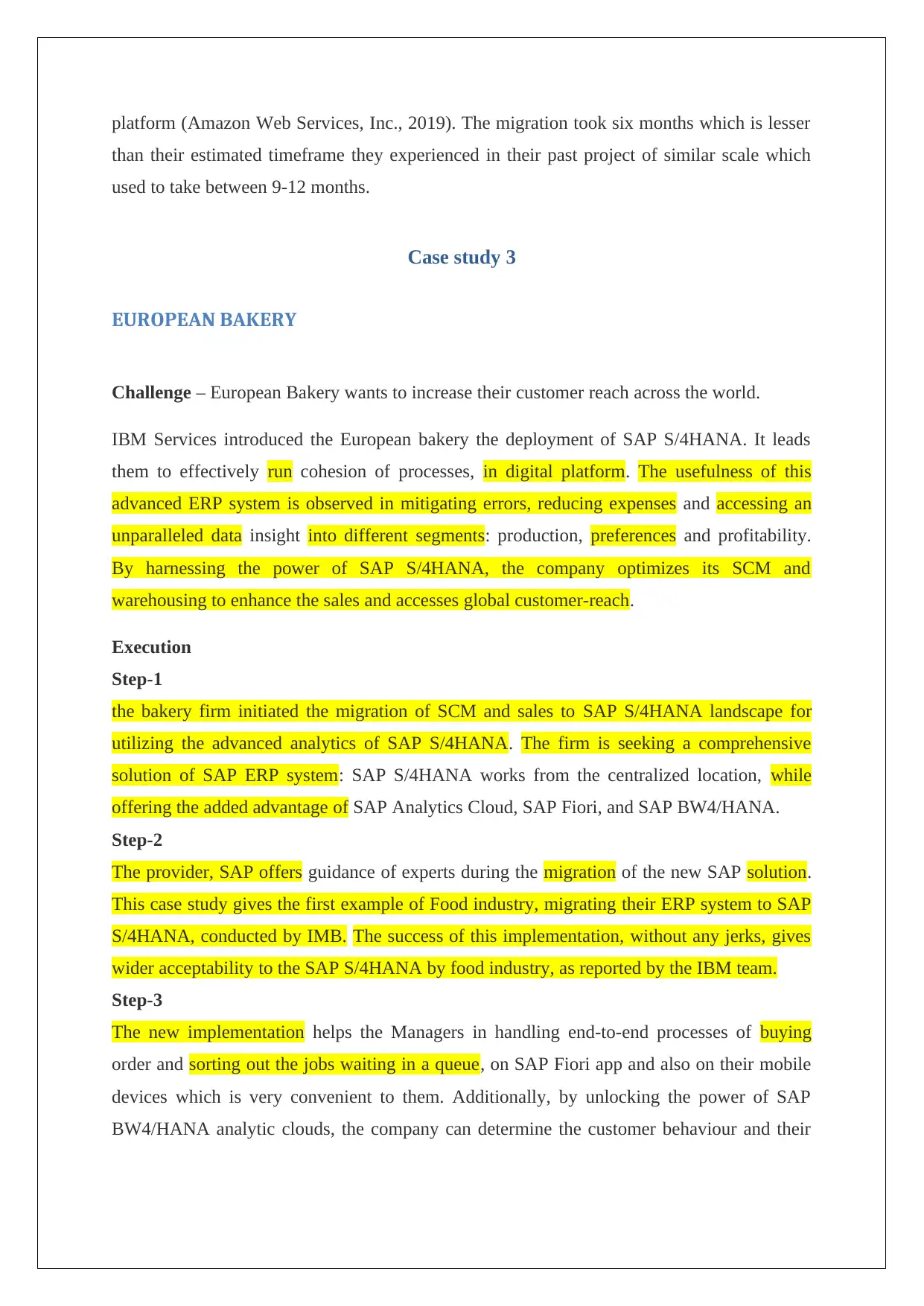
platform (Amazon Web Services, Inc., 2019). The migration took six months which is lesser
than their estimated timeframe they experienced in their past project of similar scale which
used to take between 9-12 months.
Case study 3
EUROPEAN BAKERY
Challenge – European Bakery wants to increase their customer reach across the world.
IBM Services introduced the European bakery the deployment of SAP S/4HANA. It leads
them to effectively run cohesion of processes, in digital platform. The usefulness of this
advanced ERP system is observed in mitigating errors, reducing expenses and accessing an
unparalleled data insight into different segments: production, preferences and profitability.
By harnessing the power of SAP S/4HANA, the company optimizes its SCM and
warehousing to enhance the sales and accesses global customer-reach.
Execution
Step-1
the bakery firm initiated the migration of SCM and sales to SAP S/4HANA landscape for
utilizing the advanced analytics of SAP S/4HANA. The firm is seeking a comprehensive
solution of SAP ERP system: SAP S/4HANA works from the centralized location, while
offering the added advantage of SAP Analytics Cloud, SAP Fiori, and SAP BW4/HANA.
Step-2
The provider, SAP offers guidance of experts during the migration of the new SAP solution.
This case study gives the first example of Food industry, migrating their ERP system to SAP
S/4HANA, conducted by IMB. The success of this implementation, without any jerks, gives
wider acceptability to the SAP S/4HANA by food industry, as reported by the IBM team.
Step-3
The new implementation helps the Managers in handling end-to-end processes of buying
order and sorting out the jobs waiting in a queue, on SAP Fiori app and also on their mobile
devices which is very convenient to them. Additionally, by unlocking the power of SAP
BW4/HANA analytic clouds, the company can determine the customer behaviour and their
than their estimated timeframe they experienced in their past project of similar scale which
used to take between 9-12 months.
Case study 3
EUROPEAN BAKERY
Challenge – European Bakery wants to increase their customer reach across the world.
IBM Services introduced the European bakery the deployment of SAP S/4HANA. It leads
them to effectively run cohesion of processes, in digital platform. The usefulness of this
advanced ERP system is observed in mitigating errors, reducing expenses and accessing an
unparalleled data insight into different segments: production, preferences and profitability.
By harnessing the power of SAP S/4HANA, the company optimizes its SCM and
warehousing to enhance the sales and accesses global customer-reach.
Execution
Step-1
the bakery firm initiated the migration of SCM and sales to SAP S/4HANA landscape for
utilizing the advanced analytics of SAP S/4HANA. The firm is seeking a comprehensive
solution of SAP ERP system: SAP S/4HANA works from the centralized location, while
offering the added advantage of SAP Analytics Cloud, SAP Fiori, and SAP BW4/HANA.
Step-2
The provider, SAP offers guidance of experts during the migration of the new SAP solution.
This case study gives the first example of Food industry, migrating their ERP system to SAP
S/4HANA, conducted by IMB. The success of this implementation, without any jerks, gives
wider acceptability to the SAP S/4HANA by food industry, as reported by the IBM team.
Step-3
The new implementation helps the Managers in handling end-to-end processes of buying
order and sorting out the jobs waiting in a queue, on SAP Fiori app and also on their mobile
devices which is very convenient to them. Additionally, by unlocking the power of SAP
BW4/HANA analytic clouds, the company can determine the customer behaviour and their
Secure Best Marks with AI Grader
Need help grading? Try our AI Grader for instant feedback on your assignments.
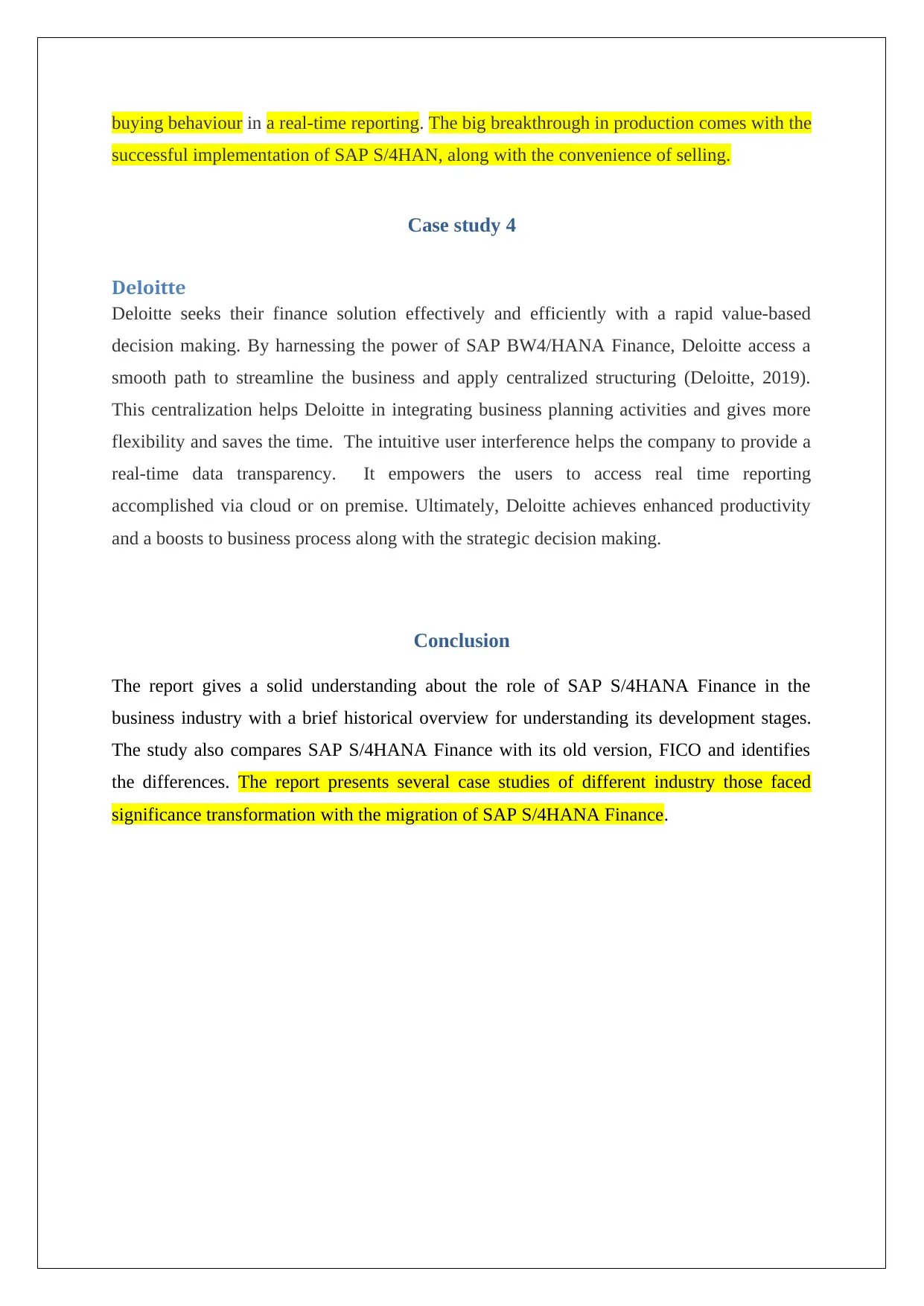
buying behaviour in a real-time reporting. The big breakthrough in production comes with the
successful implementation of SAP S/4HAN, along with the convenience of selling.
Case study 4
Deloitte
Deloitte seeks their finance solution effectively and efficiently with a rapid value-based
decision making. By harnessing the power of SAP BW4/HANA Finance, Deloitte access a
smooth path to streamline the business and apply centralized structuring (Deloitte, 2019).
This centralization helps Deloitte in integrating business planning activities and gives more
flexibility and saves the time. The intuitive user interference helps the company to provide a
real-time data transparency. It empowers the users to access real time reporting
accomplished via cloud or on premise. Ultimately, Deloitte achieves enhanced productivity
and a boosts to business process along with the strategic decision making.
Conclusion
The report gives a solid understanding about the role of SAP S/4HANA Finance in the
business industry with a brief historical overview for understanding its development stages.
The study also compares SAP S/4HANA Finance with its old version, FICO and identifies
the differences. The report presents several case studies of different industry those faced
significance transformation with the migration of SAP S/4HANA Finance.
successful implementation of SAP S/4HAN, along with the convenience of selling.
Case study 4
Deloitte
Deloitte seeks their finance solution effectively and efficiently with a rapid value-based
decision making. By harnessing the power of SAP BW4/HANA Finance, Deloitte access a
smooth path to streamline the business and apply centralized structuring (Deloitte, 2019).
This centralization helps Deloitte in integrating business planning activities and gives more
flexibility and saves the time. The intuitive user interference helps the company to provide a
real-time data transparency. It empowers the users to access real time reporting
accomplished via cloud or on premise. Ultimately, Deloitte achieves enhanced productivity
and a boosts to business process along with the strategic decision making.
Conclusion
The report gives a solid understanding about the role of SAP S/4HANA Finance in the
business industry with a brief historical overview for understanding its development stages.
The study also compares SAP S/4HANA Finance with its old version, FICO and identifies
the differences. The report presents several case studies of different industry those faced
significance transformation with the migration of SAP S/4HANA Finance.
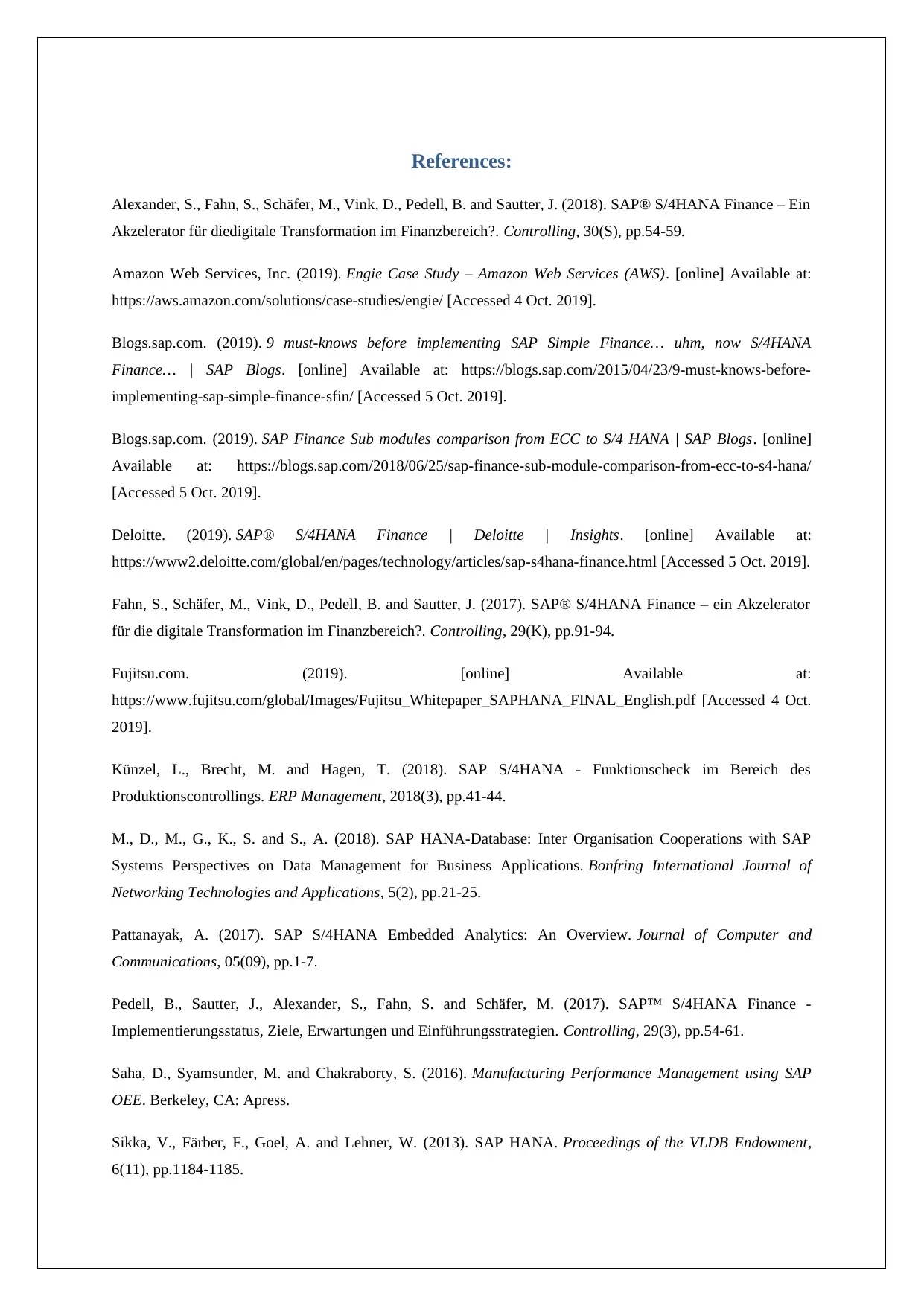
References:
Alexander, S., Fahn, S., Schäfer, M., Vink, D., Pedell, B. and Sautter, J. (2018). SAP® S/4HANA Finance – Ein
Akzelerator für diedigitale Transformation im Finanzbereich?. Controlling, 30(S), pp.54-59.
Amazon Web Services, Inc. (2019). Engie Case Study – Amazon Web Services (AWS). [online] Available at:
https://aws.amazon.com/solutions/case-studies/engie/ [Accessed 4 Oct. 2019].
Blogs.sap.com. (2019). 9 must-knows before implementing SAP Simple Finance… uhm, now S/4HANA
Finance… | SAP Blogs. [online] Available at: https://blogs.sap.com/2015/04/23/9-must-knows-before-
implementing-sap-simple-finance-sfin/ [Accessed 5 Oct. 2019].
Blogs.sap.com. (2019). SAP Finance Sub modules comparison from ECC to S/4 HANA | SAP Blogs. [online]
Available at: https://blogs.sap.com/2018/06/25/sap-finance-sub-module-comparison-from-ecc-to-s4-hana/
[Accessed 5 Oct. 2019].
Deloitte. (2019). SAP® S/4HANA Finance | Deloitte | Insights. [online] Available at:
https://www2.deloitte.com/global/en/pages/technology/articles/sap-s4hana-finance.html [Accessed 5 Oct. 2019].
Fahn, S., Schäfer, M., Vink, D., Pedell, B. and Sautter, J. (2017). SAP® S/4HANA Finance – ein Akzelerator
für die digitale Transformation im Finanzbereich?. Controlling, 29(K), pp.91-94.
Fujitsu.com. (2019). [online] Available at:
https://www.fujitsu.com/global/Images/Fujitsu_Whitepaper_SAPHANA_FINAL_English.pdf [Accessed 4 Oct.
2019].
Künzel, L., Brecht, M. and Hagen, T. (2018). SAP S/4HANA - Funktionscheck im Bereich des
Produktionscontrollings. ERP Management, 2018(3), pp.41-44.
M., D., M., G., K., S. and S., A. (2018). SAP HANA-Database: Inter Organisation Cooperations with SAP
Systems Perspectives on Data Management for Business Applications. Bonfring International Journal of
Networking Technologies and Applications, 5(2), pp.21-25.
Pattanayak, A. (2017). SAP S/4HANA Embedded Analytics: An Overview. Journal of Computer and
Communications, 05(09), pp.1-7.
Pedell, B., Sautter, J., Alexander, S., Fahn, S. and Schäfer, M. (2017). SAP™ S/4HANA Finance -
Implementierungsstatus, Ziele, Erwartungen und Einführungsstrategien. Controlling, 29(3), pp.54-61.
Saha, D., Syamsunder, M. and Chakraborty, S. (2016). Manufacturing Performance Management using SAP
OEE. Berkeley, CA: Apress.
Sikka, V., Färber, F., Goel, A. and Lehner, W. (2013). SAP HANA. Proceedings of the VLDB Endowment,
6(11), pp.1184-1185.
Alexander, S., Fahn, S., Schäfer, M., Vink, D., Pedell, B. and Sautter, J. (2018). SAP® S/4HANA Finance – Ein
Akzelerator für diedigitale Transformation im Finanzbereich?. Controlling, 30(S), pp.54-59.
Amazon Web Services, Inc. (2019). Engie Case Study – Amazon Web Services (AWS). [online] Available at:
https://aws.amazon.com/solutions/case-studies/engie/ [Accessed 4 Oct. 2019].
Blogs.sap.com. (2019). 9 must-knows before implementing SAP Simple Finance… uhm, now S/4HANA
Finance… | SAP Blogs. [online] Available at: https://blogs.sap.com/2015/04/23/9-must-knows-before-
implementing-sap-simple-finance-sfin/ [Accessed 5 Oct. 2019].
Blogs.sap.com. (2019). SAP Finance Sub modules comparison from ECC to S/4 HANA | SAP Blogs. [online]
Available at: https://blogs.sap.com/2018/06/25/sap-finance-sub-module-comparison-from-ecc-to-s4-hana/
[Accessed 5 Oct. 2019].
Deloitte. (2019). SAP® S/4HANA Finance | Deloitte | Insights. [online] Available at:
https://www2.deloitte.com/global/en/pages/technology/articles/sap-s4hana-finance.html [Accessed 5 Oct. 2019].
Fahn, S., Schäfer, M., Vink, D., Pedell, B. and Sautter, J. (2017). SAP® S/4HANA Finance – ein Akzelerator
für die digitale Transformation im Finanzbereich?. Controlling, 29(K), pp.91-94.
Fujitsu.com. (2019). [online] Available at:
https://www.fujitsu.com/global/Images/Fujitsu_Whitepaper_SAPHANA_FINAL_English.pdf [Accessed 4 Oct.
2019].
Künzel, L., Brecht, M. and Hagen, T. (2018). SAP S/4HANA - Funktionscheck im Bereich des
Produktionscontrollings. ERP Management, 2018(3), pp.41-44.
M., D., M., G., K., S. and S., A. (2018). SAP HANA-Database: Inter Organisation Cooperations with SAP
Systems Perspectives on Data Management for Business Applications. Bonfring International Journal of
Networking Technologies and Applications, 5(2), pp.21-25.
Pattanayak, A. (2017). SAP S/4HANA Embedded Analytics: An Overview. Journal of Computer and
Communications, 05(09), pp.1-7.
Pedell, B., Sautter, J., Alexander, S., Fahn, S. and Schäfer, M. (2017). SAP™ S/4HANA Finance -
Implementierungsstatus, Ziele, Erwartungen und Einführungsstrategien. Controlling, 29(3), pp.54-61.
Saha, D., Syamsunder, M. and Chakraborty, S. (2016). Manufacturing Performance Management using SAP
OEE. Berkeley, CA: Apress.
Sikka, V., Färber, F., Goel, A. and Lehner, W. (2013). SAP HANA. Proceedings of the VLDB Endowment,
6(11), pp.1184-1185.

Warnecke, B. (2017). Vom Customizing zurück zum SAP-Standard – Möglichkeiten und Grenzen bei der
Migration auf SAP S/4HANA. HMD Praxis der Wirtschaftsinformatik, 55(1), pp.151-162.
Zarantech.com. (2019). [online] Available at: https://www.zarantech.com/blog/business-benefits-of-sap-s4hana-
simple-finance/ [Accessed 4 Oct. 2019].
Migration auf SAP S/4HANA. HMD Praxis der Wirtschaftsinformatik, 55(1), pp.151-162.
Zarantech.com. (2019). [online] Available at: https://www.zarantech.com/blog/business-benefits-of-sap-s4hana-
simple-finance/ [Accessed 4 Oct. 2019].
1 out of 13
Related Documents
Your All-in-One AI-Powered Toolkit for Academic Success.
+13062052269
info@desklib.com
Available 24*7 on WhatsApp / Email
![[object Object]](/_next/static/media/star-bottom.7253800d.svg)
Unlock your academic potential
© 2024 | Zucol Services PVT LTD | All rights reserved.




